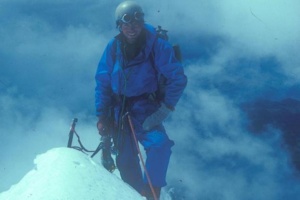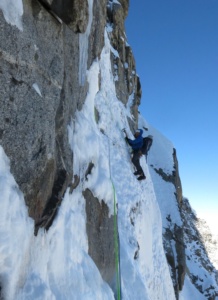Since his early days, Mick Fowler was more interested in how a mountain was climbed, rather than tread the beaten part to the top. After a successful career in taxation and battling cancer, the Englishman continues to chase his first love, climbing.

First published:
https://www.livemint.com/Leisure/rfEINlbp2sCkR7XgrSjvkI/Mick-Fowler-the-taxman-who-survived-cancer-retirement-to-c.html
Mick Fowler’s constant fight to continue climbing
At The Himalayan Club’s annual seminar in Mumbai, Mick Fowler explained just why he retired from his day job at the age of 61, but continues to scramble up mountains in faraway lands even today
Among the many box files Mick Fowler has lined up on his shelf, one stands out. Most of the others hold complex valuation data related to his job at the UK tax office; one, however, is a compilation of gorgeous mountains that comprises his list of possible objectives for the future.
The first defines his livelihood, the other, his lifeline.
At The Himalayan Club’s annual seminar in Mumbai over the weekend, the British climber explained just why he retired from his day job at the age of 61, but continues to scramble up mountains in faraway lands even today. It’s this hunger for new routes that has earned him various first ascents, including three climbs—the North Face of Siguniang, China (2002), Prow of Shiva, India (2012) and Gave Ding, Nepal (2015)—that were considered worthy of the Piolets d’Or, a prestigious French award that recognizes bold attempts.
His first few climbs while growing up in the north London suburb of Wembley, England, were alongside his father, George, who was reluctant initially, before succumbing to the constant badgering by his son. Soon, Fowler was taking to sea cliffs along the coastline or setting out on weekend road trips to Scotland in winter for ice climbing.
This wasn’t so much about the reputation of a crag or its height, but about exploring beautiful lines on rock faces. It was climbing for fun, rather than for recognition. As a result, Fowler was always some distance from the glamour world of the 8,000ers.
“Firstly, I quite like my fingers and toes and prefer my brain to be vaguely aware of what’s going on around me,” he says tongue-in-cheek, referring to the travails of high altitude. “So I found the greatest pleasure in climbing mountains lower than 6,500m.”

It didn’t matter, then, whether it was tackling the chalk cliffs at Dover with ice axes and crampons or getting busted by the police for “ice climbing” a leaking toilet pipe outside St Pancras railway station in London in the middle of the night—the first and only ascent given that the fire brigade destroyed it the next day.
He soon become a regular on the climbing circuit, where Saturday nights were spent at the disco, followed by wired, pre-dawn mornings at the railway station, awaiting the first train to head out to the heights.
However, when the time for employment came about, Fowler chose the security of a conventional desk job, instead of earning a living on the mountains.
“In between climbing trips, I ended up joining the tax office, simply because it paid the most. After a while, whenever I was about to quit to go climbing, they promoted me, handed me extra holidays and asked me to come back. It also saved me the trouble of finding another job on my return, so I stuck around,” he says.
The first time he ever sat on a plane and travelled outside Europe was in 1982, on a visit to Peru to climb Taulliraju (5,830m). Standing on the summit after more than four days—the longest he had been on a mountain—he saw the roof of the Amazon forest to his left and the dry foothills leading to the Atacama Desert on the right. It infused the desire to see remote lands.
On his first stint on the high mountains a couple of years later, it all went quite wrong for the team. The preparation to take on Bojohagur Duanasir (7,329m) in Pakistan’s Hunza Valley just didn’t match up, neither did the experience.
“It was a learning curve. For instance, we were recommended sleeping pills to help rest at those altitudes. While bivouacking one night, I suddenly felt the rope pin me down across the chest. I soon realized that my partner, Chris Watts, had fallen off the ledge and was dangling in thin air. We were so groggy that it took an effort to pull him back up,” he says, laughing.
Mountains were discovered through photographs in magazines and on the internet. After a follow-up with the photographer and the understanding of a likely approach route, Fowler would set off once the permits were in place. The distant locations meant getting to the base of the mountain was nothing short of an exploratory expedition, before spending weeks hanging by ropes in relative wilderness.
Just last year, Fowler was diagnosed with cancer, which forced him to cancel a trip to Zanskar Valley. A few months of treatment followed, and even as the recovery continues, the groundwork is already under way for the next adventure later this year.
“These days, we simply don’t rush up mountains, and prefer climbing it at our own pace. You see, I’m so old that I’ve even retired,” he chuckles.
The retirement fund will be put to good use in the years to come.